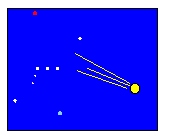 |
Astronomy 101 Problem Set #6 |  |
This Problem Set is due by 1:00 pm on Thursday, 13 October
 |
Astronomy 101 Problem Set #6 |  |
This Problem Set is due by 1:00 pm on Thursday, 13 October
Problem #1: Pluto's moon Charon has a radius of 635 km, and a mass of 1.8 x 1021 kg. What is its average density?
Based on this result, what kind of material do you think Charon is made of? (Hint: You can find the densities of various materials on the 30 September web page.)
Problem #2: A 60-watt light bulb emits 60 joules/sec of energy ( 1 Joule/sec == 1 watt). Pretend for a moment that all of this energy is emitted in the form of photons with wavelength of 600 nm (this isn't true, of course -- as a blackbody, a light bulb emits photons of a wide range in wavelengths). Calculate how many photons per second are emitted by such a light bulb.
Problem #3: Read the Executive Summary of the Department of Energy's Report, Emissions of Greenhouse Gases in the United States 2003 and answer the following questions:
a) How many metric tons of anthropogenic carbon dioxide were emitted from US sources in 2003?
b) What is the percentage increase in the US-generated carbon dioxide emissions since 1990?
c) Which sector of the US economy (e.g., residential, commercial, industrial, or transportation) is responsible for the largest fraction of 2003 carbon dioxide emissions?
d) US emissions of which greenhouse gases actually decreased between 2002 and 2003?
e) Based on the information in Table 3 of Chapter 1 of this report, by what amount would we have to reduce yearly anthropogenic carbon dioxide emissions to result in no increase in carbon dioxide in our atmosphere?
f) By what fraction of current worldwide human-made emissions levels would we have to reduce to achieve this goal?
